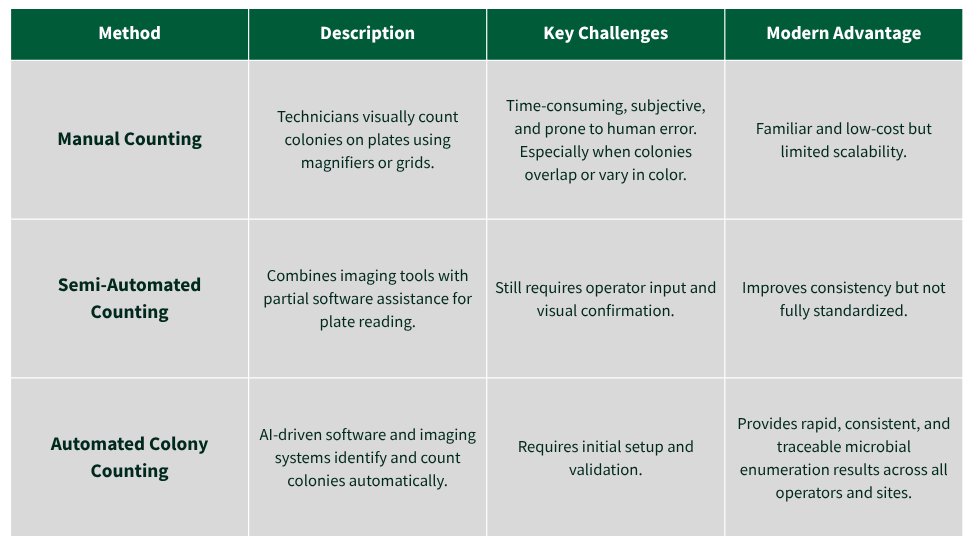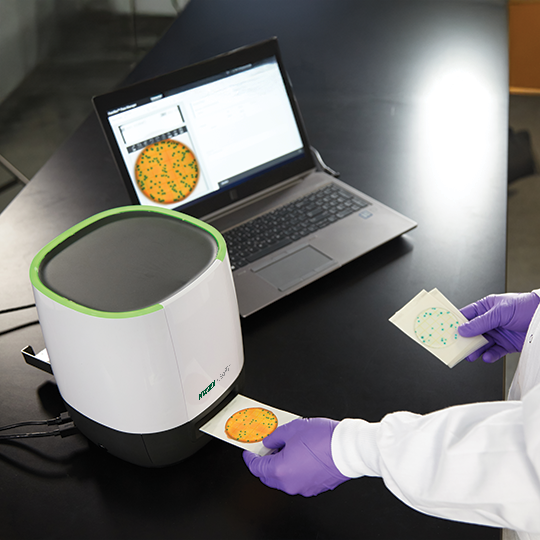Colony Counting 2.0: How Automation is Transforming Microbial Enumeration
octubre 30, 2025

A Smarter Future for Microbial Enumeration
Colony counting is the process of identifying and quantifying microbial colonies on a plate. It is the foundation of food safety testing and quality control. As labs face higher sample volumes and tighter turnaround times, automation is redefining how microbial enumeration and plate reading are performed.
The Challenge of Traditional Microbial Counting Methods
Manual microbial counting methods have long been standard in laboratories. However, they present ongoing challenges:
- Labor-intensive: Each plate must be visually inspected, often under magnification.
- Variable: Interpretations can differ between technicians.
- Time-consuming: High-volume labs can spend hours each day on plate reading.
Even the most experienced analysts can find manual counting difficult when colonies overlap or when color variations are subtle. That’s where automation adds measurable value.
Comparing Microbial Counting Methods
Microbial counting methods have evolved from manual observation to advanced digital automation. Understanding the difference helps laboratories choose the right approach for their testing volume, accuracy needs, and efficiency goals.

To overcome these challenges, laboratories are turning to automated colony counters that transform microbial enumeration into a faster, more reliable, and scalable process.
Automation’s Role in Modern Plate Reading

Automated colony counters like Neogen® Petrifilm® Plate Reader Advanced combine enhanced imaging with fixed artificial intelligence to detect and count colonies in seconds.
Here’s how it works:
- High-resolution imaging captures the full Neogen® Petrifilm® Plate
- Algorithmic analysis differentiates colonies based on size, color, and other defining characteristics.
- Automated results are displayed digitally, providing accurate and consistent counts.
This approach standardizes microbial counting across operators and sites, which is an essential factor in the food safety industry.
Understanding Microbial Interpretation
The Microbial Interpretation Technical Bulletin from Neogen explains how the Petrifilm Plate Reader Advanced interprets microbial growth patterns. Each type of Petrifilm Plate is tailored to highlight unique colony traits, examples:
- Aerobic Count (AC): Red colonies indicating general aerobic bacteria
- Coliform Count (CC): Red colonies with gas bubbles
- Rapid Yeast and Mold (YM): Blue, green, or pink/tan colonies with distinctive features
By automating plate reading, the system helps ensure each colony type is identified correctly according to its physical and chromatic characteristics, helping labs maintain confidence in their data without slowing down workflow.
Benefits of Automated Colony Counting
Automation in colony counting offers both substantial improvements:
- Accuracy: Advanced image recognition and colony differentiation.
- Consistency: Every plate is read using the same algorithms, minimizing human error.
- Efficiency: Results are processed in 6 seconds or less, increasing throughput.
- Traceability: Digital records enhance documentation and compliance.
- Scalability: Works efficiently for both small and large laboratories.
Together, these advantages make automated microbial counting a cornerstone of modern quality assurance programs.
Why Automation Matters for Every Laboratory
Whether a facility runs dozens or hundreds of samples per day, automation enhances both productivity and confidence in results. Smaller labs can rely on consistent performance without adding labor costs, while larger operations benefit from scalable, standardized microbial enumeration.
By integrating automation into daily workflows, labs can reduce manual variability, enhance audit readiness, and deliver faster, broader insights, critical benefits in the fast-moving world of food safety testing.
The Future of Colony Counting
The transition from manual microbial counting methods to automated systems reflects a broader shift in microbiology: the move toward digitization and traceable data.
The Petrifilm Plate Reader Advanced is more than an automated colony counter, it’s a platform that bridges traditional microbiological methods with modern efficiency. This balance of accuracy, speed, and simplicity empowers laboratories to meet global standards while keeping pace with industry innovation.
FAQ: Colony Counting & Microbial Enumeration
- What is colony counting?
Colony counting is the process of determining the number of microbial colonies that grow on a nutrient medium after incubation. Each colony represents one or more viable microorganisms present in the original sample.
- Why is automated colony counting important?
Automation reduces human error, saves time, and helps ensure consistent interpretation across multiple technicians and testing locations.
- How does the Petrifilm Plate Reader Advanced perform microbial enumeration?
It uses advanced imaging and software algorithms to analyze digital images of Petrifilm Plates, automatically identifying and counting colonies with precision.
Conclusion
Automation is transforming how laboratories approach colony counting and microbial enumeration. With innovations like the Petrifilm Plate Reader Advanced, labs can start to improve consistency and speed, empowering technicians to focus on insights, not manual counts.
Ready to modernize your microbial counting methods?
Discover the Petrifilm Plate Reader Advanced and see how Neogen is driving innovation in colony counting and plate reading technology.
Categoría: Inocuidad Alimentaria, Microbiología, Petrifilm®